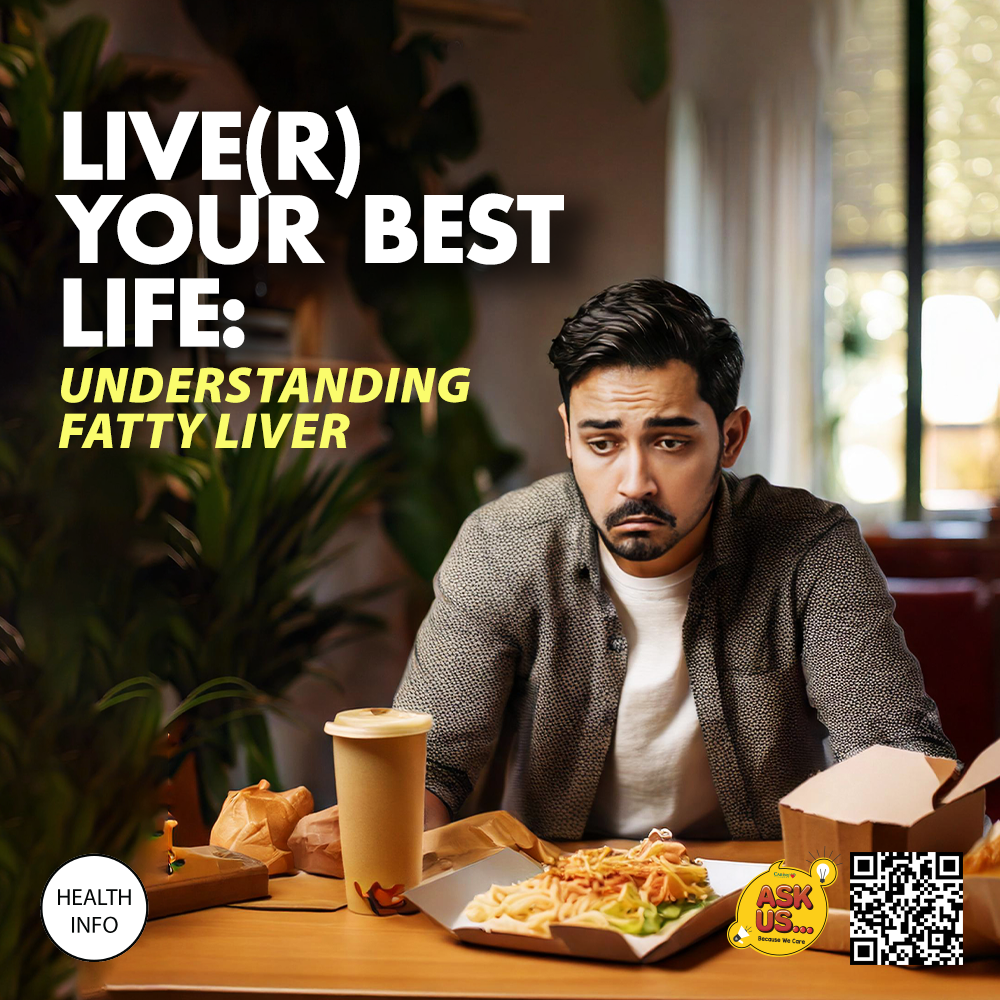- Home
- Health Center
- Health Info
- Live(r) Your Best Life: Understanding Fatty Liver
Liver
Live(r) Your Best Life: Understanding Fatty Liver


The liver, which is classified as the largest solid organ in the body, performs over 500 vital functions – some of these roles include detoxifying blood, producing bile to break down fats, managing glucose storage, and uptake of essential vitamins. Despite its remarkable capabilities, it can be compromised by a condition called fatty liver, where excessive fat accumulates in liver cells, impairing its ability to function.
Fatty liver occurs when triglycerides and other fats account for more than 5-10% of the liver’s weight. It is categorized into two types: Non-Alcoholic Fatty Liver Disease (NAFLD) and Alcoholic Liver Disease.
NAFLD progresses through four stages:
1. Stage 1: Simple Fatty Liver (Steatosis) – Harmless fat buildup in liver cells.
2. Stage 2: Non-Alcoholic Steatohepatitis (NASH) – Involves liver inflammation and potential damage.
3. Stage 3: Fibrosis – Scar tissue develops, though liver function remains intact.
4. Stage 4: Cirrhosis – Severe scarring that can lead to liver failure or cancer.
Alcoholic Liver Disease, on the other hand, is directly linked to excessive alcohol consumption, which inflames and scars the liver, potentially causing life-threatening complications.
Fatty liver is often asymptomatic, but advanced stages may cause symptoms such as fatigue, abdominal pain, yellowing of the skin and eyes, or swelling in the belly and legs. Diagnosis typically involves blood tests to detect elevated liver enzymes, imaging techniques like ultrasounds, or liver biopsies to assess disease progression.
Key risk factors that can potentially lead to fatty liver include:
– Being overweight or obese.
– Type 2 diabetes or metabolic syndrome.
– High cholesterol and triglycerides.
– Chronic alcohol consumption.
– Certain medications (consult your pharmacist for more details).
While there is no definitive cure for fatty liver, lifestyle changes can prevent and reverse early stages of the condition. Some of these modifications include the following:
1. Limiting Alcohol: Restrict alcohol intake to prevent further liver damage (up to 2 drinks/day for men, 1 for women).
2. Adopting a Healthy Diet: Focus on a balanced diet rich in fruits, vegetables, whole grains, lean protein, and healthy fats like those found in olive oil and fish. The Mediterranean diet is particularly beneficial.
3. Exercising Regularly: Aim for at least 30 minutes of moderate activity most days to reduce liver fat and maintain a healthy weight.
4. Managing Underlying Conditions: Ensure proper control of diabetes, high cholesterol, and blood pressure with appropriate medication and lifestyle adjustments.
5. Quit Smoking: Smoking exacerbates liver damage and increases the risk of cardiovascular disease.
In conclusion, fatty liver is a manageable condition if detected early. By adopting healthier habits, limiting alcohol, and seeking regular medical advice, you can protect your liver and improve your overall well-being. Visit your nearest CARiNG Pharmacy for expert guidance on liver health and supplements—we’re here to support you every step of the way!
References:
- Fatty Liver Disease. Cleveland Clinic. (Web accessed January 2022). Web link: https://my.clevelandclinic.org/health/diseases/15831-fatty-liver-disease#:~:text=Fatty%20liver%20disease%20(steatosis)%20is,10%25%20of%20your%20liver%27s%20weight
- Fatty Liver. E Tommolino, Medscape. (Web accessed January 2022). Web link: https://emedicine.medscape.com/article/175472-overview#a1
- Non-alcoholic fatty liver disease (NAFLD). NHS UK. (Web accessed January 2022). Web link: https://www.nhs.uk/conditions/non-alcoholic-fatty-liver-disease/
- 13 Ways to a Healthy Liver. American Liver Foundation. (Web accessed January 2022). Web link: https://liverfoundation.org/13-ways-to-a-healthy-liver/
- Fatty liver disease in diabetes mellitus. HB Bhatt and RJ Smith (2015). Hepatobiliary Surgery and Nutrition.
- Cholesterol-Induced Non-Alcoholic Fatty Liver Disease and Atherosclerosis Aggravated by Systemic Inflammation. EJ Kim et al. (2014). PLoS One.
Latest Health Info
Healthy Weight, Happy Joints
How Does Weight Affect Knee Health? The Link Between Pounds And Pain Osteoarthritis (OA) involves the degeneration of joints, which ...
The Gut Warriors: Prebiotics, Probiotics and Postbiotics
When it comes to gut health, you’ve probably heard of prebiotics and probiotics. But did you know there’s also ...
Tip Moreh: Masa Berbuka Puasa
Moreh adalah tradisi unik yang biasanya diadakan selepas solat tarawih pada bulan Ramadan. Ia melibatkan penyediaan dan perkongsian makanan ringan ...



